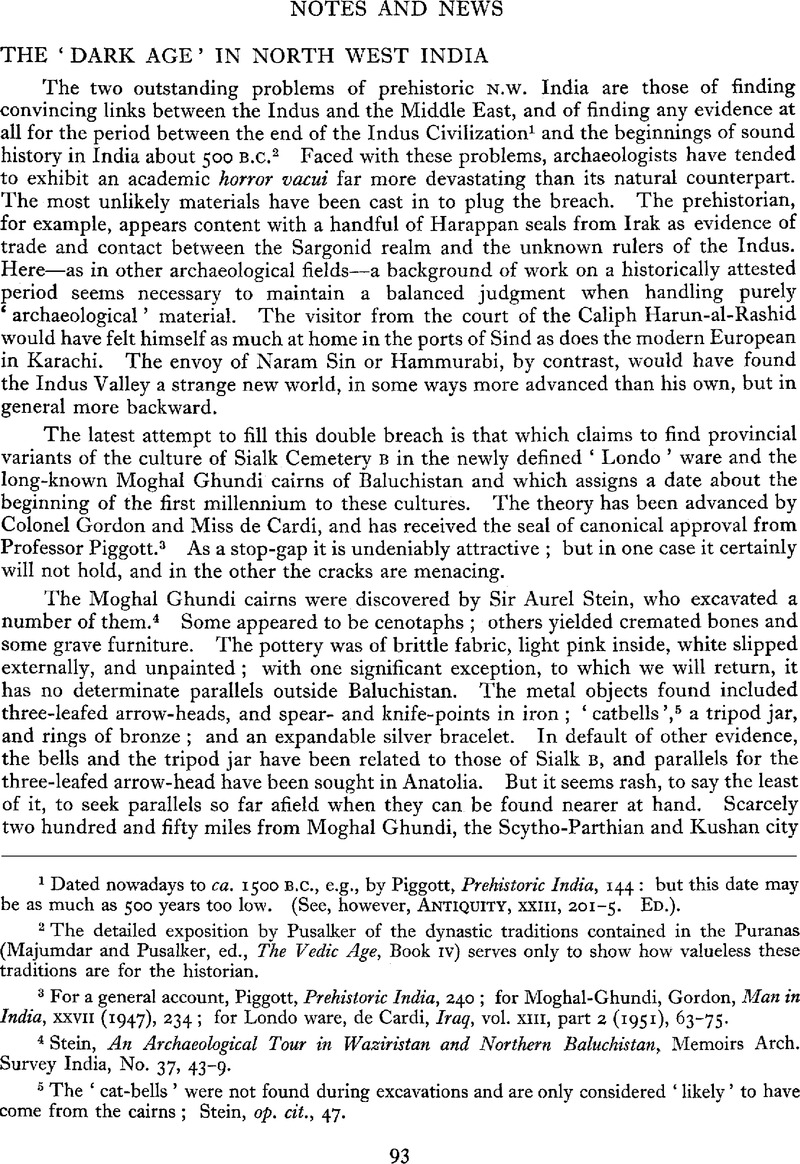Article contents
The ‘Dark Age’ In North West India
Published online by Cambridge University Press: 02 January 2015
Abstract

- Type
- Notes and News
- Information
- Copyright
- Copyright © Antiquity Publications Ltd. 1952
References
1 Dated nowadays to ca. 1500 B.c., e.g., by Piggott, , Prehistoric India, 144 Google Scholar: but this date may be as much as 500 years too low. (See, however, ANTIQUITY, XXIII, 201-5. ED.).
2 The detailed exposition by Pusalker of the dynastic traditions contained in the Puranas (Majumdar and Pusalker, ed., The Vedic Age, Book IV) serves only to show how valueless these traditions are for the historian.
3 For a general account, Piggott, , Prehistoric India, 240 Google Scholar; for Moghal-Ghundi, Gordon, Man in India, XXVII (1947), 234 Google Scholar; for Londo ware, de Cardi, , Iraq, vol. XIII, part 2 (1951), 63–75 CrossRefGoogle Scholar.
4 Stein, An Archaeological Tour in Waziristan and Northern Baluchistan, Memoirs Arch. Survey India, No. 37, 43-9.
5 The ‘cat-bells’ were not found during excavations and are only considered ‘likely’ to have come from the cairns; Stein, op. cit., 47.
6 Three-leafed arrow-heads at Sirkap; Archaeological Survey of India, Annual Report, 1914-15, pl. X; tripod jars from Sirkap, ASIR, 1926-7, pl. XXVIII, 1, and other unpublished specimens in Taxila Museum. Three-leafed arrow-heads have also been found at the Arab port of Bhambor, Sind, where they probably date to the 9th century A.D.
7 Stein, op. cit., 48. Unfortunately Stein does not illustrate the design of the ring; and the Archaeological Survey of India appears to have no knowledge of it.
8 Stein, op. cit., 47-8 and pl. x.
8 In Iraq, 1951, with references to painted sherds previously illustrated by Stein.
10 The Sialk comparisons have been made with the material illustrated by Schaeffer in Stratigraphie Comparée … de l'Asie occidentale.
11 Stein, Archaeological Reconnaissances in N.W. India and S.E. Iran, passim.; Innermost Asia, chaps, XXIX-XXX.
12 Piggott in Ancient India, No. 5. Since this article was published further reconnaissances around Quetta have confirmed the attribution of the Lahore Museum pot to the Quetta region, and have yielded further samples of this fabric.
- 1
- Cited by




